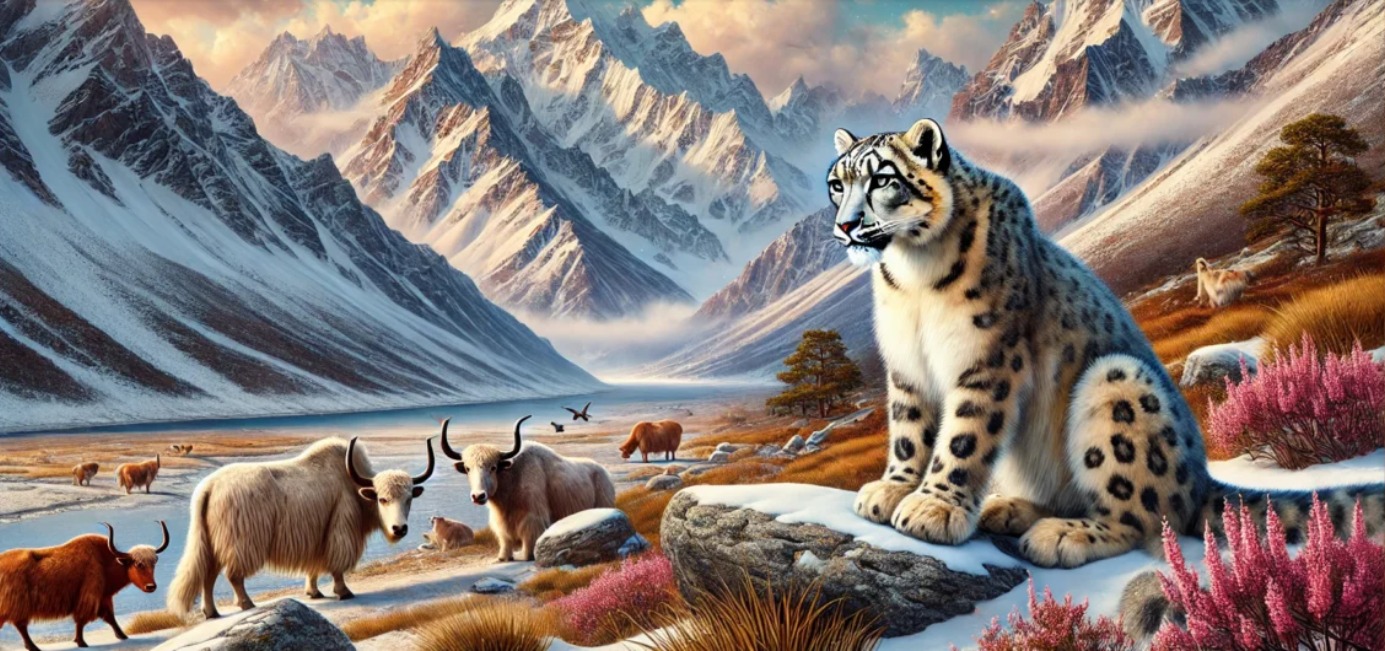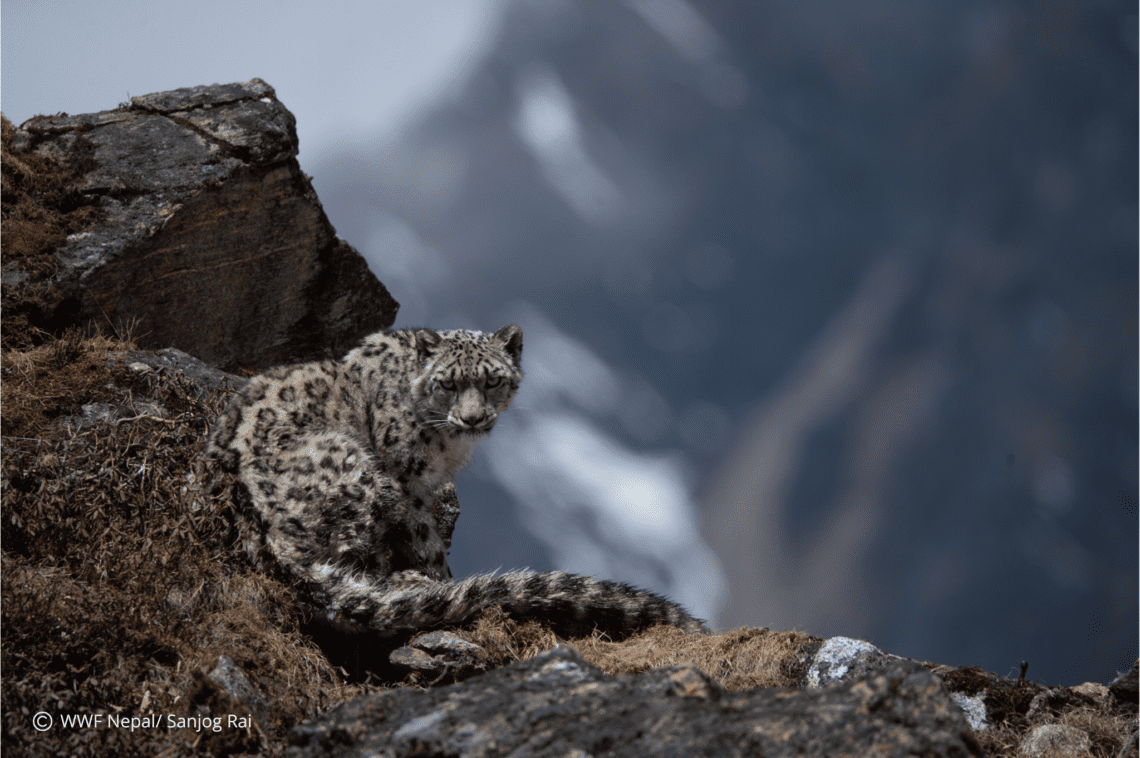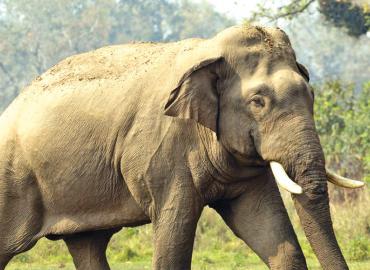- Prem Prasad Bastola, Raju Jhallu Prassad
Kathmandu: The snow leopard, often hailed as the queen of the mountains, is a crucial species that signifies the health of mountain ecosystems and plays a pivotal role in the natural food chain. Unfortunately, this majestic animal faces numerous threats, including wildlife crime, the effects of climate change, and retaliatory killings. As one of the least studied wild cat species globally, it is imperative to maintain ongoing conservation and research efforts for the snow leopard.
In this regard, a comprehensive survey of snow leopard populations has been successfully conducted in the Kangchenjunga Conservation Area. This initiative was coordinated by the Department of National Parks and Wildlife Conservation under Nepal’s Ministry of Forests and Environment, with vital financial and technical support from WWF Nepal.
Given the absence of reliable global estimates for snow leopard populations, the survey by WWF Nepal in the Kangchenjunga Conservation Area is of significant importance. Current estimates suggest that there are between 350 and 500 snow leopards residing in Nepal.
According to Mr. Sushak Paudel, a wildlife biologist with WWF Nepal involved in the survey, 13 snow leopards were captured on camera traps set up for two months in the Kangchenjunga Conservation Area. He estimated that the actual number of snow leopards in the region could range from 8 to 24.
The survey utilized camera trap methods, deploying cameras at 49 locations across nearly 800 square kilometers. Participation in the survey included 36 citizen scientists and researchers from Ghunsa, Yangma, Olangchunggola, and Yamphuddin. Additionally, two staff members from the Kangchenjunga Conservation Area Management Committee and eight members from community forest user groups also contributed to the effort.
Paudel highlighted that counting snow leopards is significantly more challenging than surveying other wildlife species. He noted, “Surveying and estimating the population of snow leopards presents numerous challenges compared to counting tigers, rhinos, elephants, and birds. The mountainous habitat introduces difficulties related to weather conditions, geographical terrain, and costs. However, the relentless efforts of local communities and scientists have made this snow leopard census possible.”

He also mentioned that previous surveys relied on scat analysis over a three-year period, which accounted for all ages of snow leopards. In contrast, this survey focused solely on adult snow leopards due to the use of camera trap methods. As a result, the current data may appear lower than in previous surveys.
Government of Nepal is making continuous efforts to conserve and manage snow leopards and their habitats in collaboration and coordination with various conservation partners. Paudel emphasized that collective efforts from conservation stakeholders are essential for the long-term preservation of this iconic species and the strengthening of mountain ecosystems.
The Department of National Parks and Wildlife Conservation has published the Snow Leopard Conservation Action Plan 2024. This public action plan aims to enhance conservation efforts by integrating the various snow leopard conservation activities carried out by different stakeholders both inside and outside protected areas.
Key priority areas of this action plan include the preparation of robust data, the incorporation of climate adaptation management plans, proper management of wildlife diseases, prevention of wildlife crime, promotion of cross-border coordination, and development of sustainable infrastructure, as highlighted by Paudel.
Counting the Snow Leopards: 30 Identified in Eastern Dolpa, Totaling 120 in the Region
A systematic camera trap survey conducted from mid-April to mid-September 2023 confirmed the number of snow leopards in the Eastern Dolpa region outside Shey-Phoksundo National Park. The density of snow leopards is estimated to be 1.5 per 100 square kilometers in this area, leading to the conclusion that there are approximately 30 snow leopards within the study region.
In comparison, a similar survey conducted four years ago within the national park estimated the density of snow leopards at 2.2 per 100 square kilometers, which indicated that around 90 snow leopards resided within this protected area. Therefore, the total number of snow leopards in Dolpa has reached 120, making it the highest count in Nepal, as well as having the highest density.

This study provides significant data on the status of snow leopards and their habitats, laying the groundwork for future conservation and management efforts.
Snow Leopard Population in Nepal: Estimates Range from 300 to 500
The snow leopard, found in only 12 countries worldwide, is considered an indicator of a pristine alpine environment. Alongside Nepal, snow leopards inhabit Afghanistan, Bhutan, China, Kazakhstan, Kyrgyzstan, India, Mongolia, Russia, Pakistan, Tajikistan, and Uzbekistan. On the global map of snow leopard distribution, Nepal holds significant importance, ranking prominently after Mongolia and China.
In Nepal, the estimated snow leopard population ranges from approximately 300 to 500 individuals, while globally, it is estimated to be between 4,000 and 6,500. This big cat species uses its long tail to maintain balance on rugged terrain.
According to Senior Ecologist Hari Bhadra Acharya, a nationwide census of snow leopards has not been feasible due to the challenging geography of high-altitude regions. Consequently, the population has been assessed by dividing the geography into different zones. The surveyed areas include the eastern Kanchanjunga to Ganesh Himal, from Manaslu to Dhaulagiri, and parts extending from the Kali Gandaki River to the Api-Nampa Conservation Area.
“Just as the tiger is an indicator of a healthy ecosystem in the Terai, the snow leopard is a key indicator of ecological health in high alpine regions,” stated Senior Ecologist Acharya. He further noted that the snow leopard is often referred to as the “Queen of the Himalayas” due to its elusive nature, which makes it difficult to spot.
Climate Change Challenges for Snow Leopard Habitats
On November 23, Nepal celebrated International Snow Leopard Day under the theme “Securing Snow Leopard Habitats for Future Generations.” This initiative emphasizes the importance of protecting the snow leopard’s natural habitat and ensuring the health of alpine ecosystems.
According to Dr. Ram Chandra Kandel, Director General of the Department of National Parks and Wildlife Conservation, climate change has had a significant impact on high-altitude areas, leading to habitat degradation for snow leopards. He noted that this degradation has resulted in a decline in the availability of prey species for the snow leopard.

“When discussing snow leopard habitats, it’s important to highlight that 40% of their habitat is within Nepal’s protected high-altitude regions, while 60% lies outside these areas. Unfortunately, such habitats are becoming fragmented,” he stated. “Additionally, challenges such as conflict-driven changes, instances of poaching, poisoning of prey, geographical difficulties, and a lack of adequate technology, manpower, and budget hinder effective monitoring.”
Emphasizing the need for collaboration and coordination among all three tiers of government for snow leopard conservation, Dr. Kandel mentioned that the department works to raise awareness within local communities. They conduct surveys to understand the current status, challenges, and potential solutions for snow leopards.
The department has also been assisting in the construction of secure enclosures to protect local sheep, goats, and yaks from snow leopard predation.
Here’s the English version of your text discussing the challenges of human-snow leopard conflict in the Himalayan region:
Challenges in Reducing Human-Snow Leopard Conflicts
The primary livelihood of local communities in the Himalayan region is livestock farming. Residents traditionally raise yaks, chauris (crossbreeds of yaks and domestic cattle), goats, and sheep. However, snow leopards have been known to enter livestock sheds and kill hundreds of animals at once. Following an incident in the Shey-Phoksundo National Park area of Dolpa, where a young girl was attacked and injured, researchers noted that such attacks on humans are rare globally.
Damage to livestock often leads to conflicts between local farmers and snow leopards. Recently, the World Wildlife Fund (WWF) Nepal has collaborated with park administrations to provide compensation to farmers for losses incurred from snow leopard attacks, which has helped reduce these conflicts.
According to Shreyan Shrestha, a representative of WWF Nepal working in the Shey-Phoksundo National Park area, 800 livestock were reported killed last year. As compensation for these losses, the park administration disbursed 25.6 million Nepali Rupees to local farmers.
Local farmer Furba Tenzing Sherpa stated that compensation has been provided for damages caused by snow leopards for the past five years. He mentioned that the community has become more actively involved in snow leopard conservation since they started receiving compensation. “Previously, it was challenging to obtain compensation. Geographically, it was also difficult to carry applications to the park office. However, since last year, with the help of WWF Nepal staff, conservation advocates, and wardens, farmers who have suffered losses are now able to receive compensation easily through bank accounts without much hassle,” he noted.
Why Conserve Snow Leopards?
Conserving snow leopards means preserving the overall ecological health of the mountains. Snow leopards play a crucial role in ensuring the long-term health of the Himalayan environment, and their population growth and habitat conservation contribute to tourism, herbal medicine preservation, and income generation.
Despite its importance, Nepal still has a long way to go in the conservation of this species, which is regarded as a symbol of the cleanliness of the Himalayan environment. It is essential for Nepal to collaborate with conservationists from Tibet in China and Sikkim and Uttarakhand in India for the “effective and practical conservation” of the snow leopard. Transboundary cooperation has become crucial for snow leopard conservation.
Moreover, there has been a recent surge in infrastructure development in the northern districts of Nepal, with an increasing network of roads expanding into grazing areas. Experts suggest that as roads reach snow leopard habitats, the animals may start to wander toward Tibet more frequently.
An adult snow leopard can weigh up to 55 kilograms and measure up to 12 feet from head to tail, standing about two feet tall. This thick-furred species is considered a symbol of a healthy Himalayan environment. As the apex predator in the Himalayan or mountainous food chain, it preys on animals like blue sheep and Himalayan ibex. However, snow leopards occasionally also prey on smaller yaks and chauris (crossbreeds of yaks and domestic cattle).
Snow leopards are typically found at altitudes ranging from 540 to 5,000 meters above sea level. The International Union for Conservation of Nature (IUCN) has listed snow leopards as globally vulnerable on its Red List.
Wild Yaks in Shey-Phoksundo National Park
Sneha Tamrakar, a communications officer at WWF Nepal, reported the sighting of wild yaks in Shey-Phoksundo National Park. Previously believed to be extinct due to a lack of data and according to local community accounts, wild yaks were observed at an altitude of 4,825 meters above sea level.
This study regarding wild yaks was conducted under the leadership of the Department of National Parks and Wildlife Conservation, in collaboration with WWF, following prior knowledge from the local community. During this study, local citizen scientists Sonam Wangdi and Urgen Gurung made significant contributions.






















